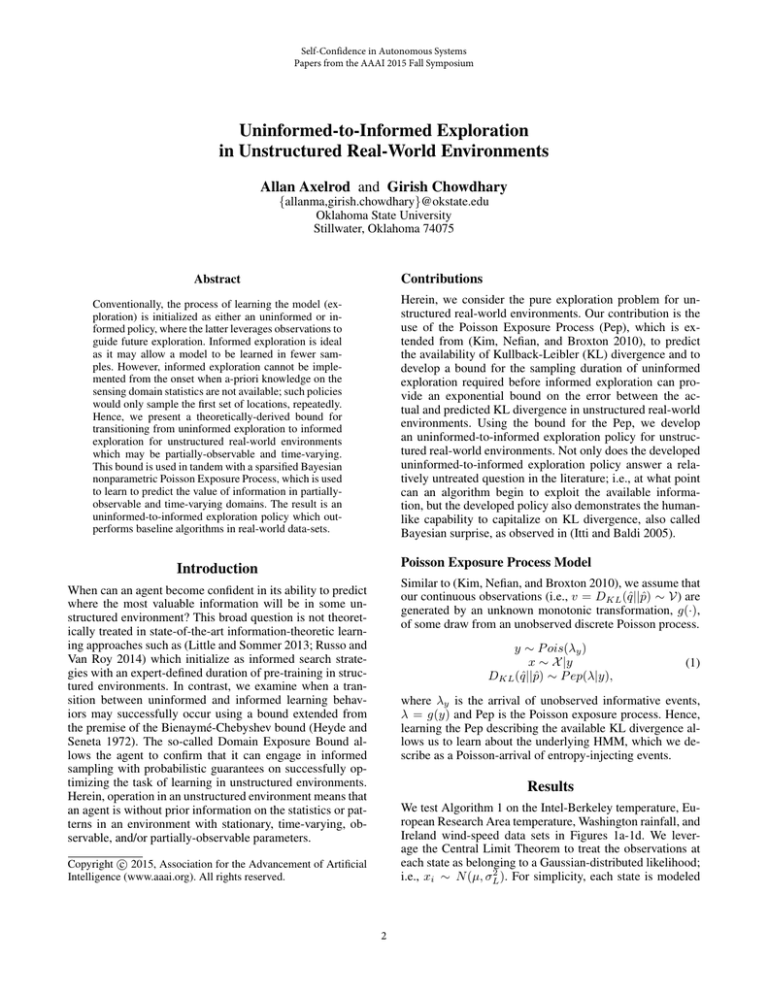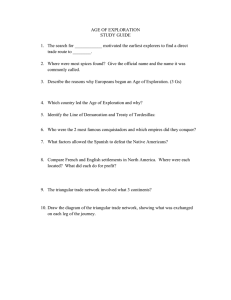
Self-Confidence in Autonomous Systems
Papers from the AAAI 2015 Fall Symposium
Uninformed-to-Informed Exploration
in Unstructured Real-World Environments
Allan Axelrod and Girish Chowdhary
{allanma,girish.chowdhary}@okstate.edu
Oklahoma State University
Stillwater, Oklahoma 74075
Contributions
Abstract
Herein, we consider the pure exploration problem for unstructured real-world environments. Our contribution is the
use of the Poisson Exposure Process (Pep), which is extended from (Kim, Nefian, and Broxton 2010), to predict
the availability of Kullback-Leibler (KL) divergence and to
develop a bound for the sampling duration of uninformed
exploration required before informed exploration can provide an exponential bound on the error between the actual and predicted KL divergence in unstructured real-world
environments. Using the bound for the Pep, we develop
an uninformed-to-informed exploration policy for unstructured real-world environments. Not only does the developed
uninformed-to-informed exploration policy answer a relatively untreated question in the literature; i.e., at what point
can an algorithm begin to exploit the available information, but the developed policy also demonstrates the humanlike capability to capitalize on KL divergence, also called
Bayesian surprise, as observed in (Itti and Baldi 2005).
Conventionally, the process of learning the model (exploration) is initialized as either an uninformed or informed policy, where the latter leverages observations to
guide future exploration. Informed exploration is ideal
as it may allow a model to be learned in fewer samples. However, informed exploration cannot be implemented from the onset when a-priori knowledge on the
sensing domain statistics are not available; such policies
would only sample the first set of locations, repeatedly.
Hence, we present a theoretically-derived bound for
transitioning from uninformed exploration to informed
exploration for unstructured real-world environments
which may be partially-observable and time-varying.
This bound is used in tandem with a sparsified Bayesian
nonparametric Poisson Exposure Process, which is used
to learn to predict the value of information in partiallyobservable and time-varying domains. The result is an
uninformed-to-informed exploration policy which outperforms baseline algorithms in real-world data-sets.
Poisson Exposure Process Model
Introduction
Similar to (Kim, Nefian, and Broxton 2010), we assume that
our continuous observations (i.e., v = DKL (q̂||p̂) ∼ V) are
generated by an unknown monotonic transformation, g(·),
of some draw from an unobserved discrete Poisson process.
When can an agent become confident in its ability to predict
where the most valuable information will be in some unstructured environment? This broad question is not theoretically treated in state-of-the-art information-theoretic learning approaches such as (Little and Sommer 2013; Russo and
Van Roy 2014) which initialize as informed search strategies with an expert-defined duration of pre-training in structured environments. In contrast, we examine when a transition between uninformed and informed learning behaviors may successfully occur using a bound extended from
the premise of the Bienaymé-Chebyshev bound (Heyde and
Seneta 1972). The so-called Domain Exposure Bound allows the agent to confirm that it can engage in informed
sampling with probabilistic guarantees on successfully optimizing the task of learning in unstructured environments.
Herein, operation in an unstructured environment means that
an agent is without prior information on the statistics or patterns in an environment with stationary, time-varying, observable, and/or partially-observable parameters.
y ∼ P ois(λy )
x ∼ X |y
DKL (q̂||p̂) ∼ P ep(λ|y),
(1)
where λy is the arrival of unobserved informative events,
λ = g(y) and Pep is the Poisson exposure process. Hence,
learning the Pep describing the available KL divergence allows us to learn about the underlying HMM, which we describe as a Poisson-arrival of entropy-injecting events.
Results
We test Algorithm 1 on the Intel-Berkeley temperature, European Research Area temperature, Washington rainfall, and
Ireland wind-speed data sets in Figures 1a-1d. We leverage the Central Limit Theorem to treat the observations at
each state as belonging to a Gaussian-distributed likelihood;
2
i.e., xi ∼ N (µ, σL
). For simplicity, each state is modeled
c 2015, Association for the Advancement of Artificial
Copyright Intelligence (www.aaai.org). All rights reserved.
2
using the Gaussian distribution as the conjugate prior. The
Bayesian update is
2
!−1
σL,i
2
2
σL,i
M µp̂ + σp̂,i ȳi
2
2
µq̂ = σ2
and σq̂ =
+ σq̂
,
M
L,i
+ σ2
Algorithm 1: RAPTOR with Pep-Cox Gaussian Process
Input: t, κ, K, c, δ, m, k
Output: Vi (τini ), E(Vi (t)), η t ∀ i, t, n
(αi , βi , ni , τi , ∆ti ) = (0, 1, 0, 0, 0) ∀ i
For each: Epoch at time t
For each: i ∈ S
∆ti ← t − τini ∀ ni ≥ 1
E[Vi |∆ti ] ← (1 − σi2 )(EGPi (∆Vi |∆ti ) + Vi (τini )) +
σi2 (EP epi (∆Vi |∆ti ) + Vi (τini ))
End For
b ← argmax ni λi (τ1n −τ 1 )
p̂,i
M
2
where µp̂ is the prior mean, µq̂ is the posterior mean, σp̂,i
2
is the prior variance, and σq̂,i is the posterior variance. The
KL divergence, DKL , for scalar normal distributions (i.e.,
d = 1) is
DKL (q̂||p̂) =
h 2 i
2
σ
σ
T
log σp̂2 + tr σ2 p̂q̂ − d + (µq̂ − µp̂ ) σp̂−2 (µq̂ − µp̂ )
q̂
% Optimal Entropy Reduction
% Optimal Entropy Reduction
2
100
80
60
Random Sampling
Sequential Sampling
PIG
Cox Point−wise RAPTOR
40
20
0
0
5000
10000
15000
t
η ← argmax
.
η⊂{1,...,K}
Random Sampling
Sequential Sampling
PIG
Cox Point−wise RAPTOR
60
40
0
0
2000
4000
6000
% Optimal Entropy Reduction
% Optimal Entropy Reduction
60
40
20
0
0
5000
10000
15000
Vi
priori knowledge of the problem domain statistics, making
them difficult to use in practice. Moreover, existing informed
exploration policies such as IDS and PIG assume that the
environment is stationary and observable, yet real-world environments are often time-varying and partially-observable.
Unstructured real-world data experiments are used to validate the resultant uninformed-to-informed-exploration policy. The probability of best-action and the entropy reduction
capability of the uninformed-to-informed-exploration policy
exceeds that of baseline informed and uninformed exploration policies both in terms of the entropy reduction and
the probability of selecting optimal actions.
(a) Intel Berkeley Temper- (b)
European
Temperaature Data Set Optimality ture Data Set Optimality
(κ=6, K=52)
(κ=6, K=50)
80
i∈η
Bound)
8000
Episode
Random Sampling
Sequential Sampling
PIG
Cox Point−wise RAPTOR
E
P
20
Episode
100
1
ncλh (DomainiExposure
subject to Car(η) ≤ κ
Else:
η t ←Uninformed Policy (Sequential, Random, etc.)
End If
ni ← ni + 1 ∀ i ∈ η t
Update: Pep-Cox Gaussian Process ∀ i ∈ ηt
End For
100
80
i
i
i
If t ≥ τbn > τb1 +
100
80
60
Random Sampling
Sequential Sampling
PIG
Cox Point−wise RAPTOR
40
20
0
0
1000
Episode
2000
3000
4000
5000
6000
Episode
(c) Washington Rainfall Data (d) Ireland Wind-Speed Data
Set Optimality (κ=2, K=25) Set Optimality (κ=2, K=12)
Acknowledgements
This work is sponsored by the Department of Energy Award
Number DE-FE0012173 and the Air Force Office of Scientific Research Award Number FA9550-14-1-0399.
Figure 1: In the above subfigures, RAPTOR sequentially explores the data set until a domain exposure bound condition
is satisfied. Once the bound is satisfied, RAPTOR has probabilistic guarantees on the prediction of Kullback-Leibler divergence, and the performance noticeably improves with respect to the baseline algorithms.
References
Heyde, C., and Seneta, E. 1972. Studies in the history of probability
and statistics. xxxi. the simple branching process, a turning point
test and a fundamental inequality: A historical note on ij bienaymé.
Biometrika 59(3):680–683.
Itti, L., and Baldi, P. F. 2005. Bayesian surprise attracts human
attention. In Advances in neural information processing systems,
547–554.
Kim, T.; Nefian, A. V.; and Broxton, M. J. 2010. Photometric recovery of apollo metric imagery with lunar-lambertian reflectance.
Electronics letters 46(9):631–633.
Little, D. Y., and Sommer, F. T. 2013. Learning and exploration in
action-perception loops. Frontiers in neural circuits 7.
Russo, D., and Van Roy, B. 2014. Learning to optimize via
information-directed sampling. In Advances in Neural Information
Processing Systems, 1583–1591.
Conclusion
Herein, we present a bound for transitioning from an uninformed exploration policy to an informed exploration policy; this allows an agent, without preprocessing or a priori knowledge, to learn to exploit the task of exploration in
partially-observable time-varying environments. The benefit of informed exploration policies which use informationtheoretic quantities as the feedback signal is that exploration
policy may minimize the amount of undiscovered information, given sufficient knowledge about the information dynamics, in an environment. However, informed exploration
policies have traditionally either required preprocessing or a
3




